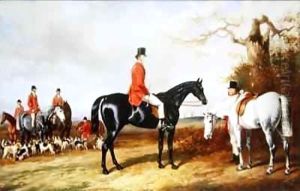W. and Barraud, H. Barraud Paintings
William Barraud and Henry Barraud were two British brothers who both became distinguished painters in the 19th century. William was born in 1810 and Henry followed in 1811, into a family with an artistic background; their elder brother, Charles Barraud, was also a painter.
William initially worked as a clerk at the Custom House in London but left this position to pursue an artistic career. He became well-known for his depictions of animals, particularly horses and dogs, often set within a landscape or amid sporting events. His attention to detail and ability to capture the spirit and anatomy of the animals gained him considerable acclaim.
Henry, on the other hand, focused more on genre scenes and portraits, although he did occasionally collaborate with William on some paintings, with Henry painting the figures and William the animals. After William's death in 1850, Henry continued to paint and also produced lithographs of their works. He was a versatile artist whose works included historical scenes and religious subjects, as well as landscapes and portraits.
Both brothers exhibited at the Royal Academy and other venues. Their works are characterized by a high level of technical skill and a keen observation of detail. William's animal paintings were particularly influential on subsequent artists, and both brothers left a lasting legacy in the field of British art.
William Barraud passed away at the relatively young age of 40 in 1850. His brother Henry lived longer, continuing to paint and exhibit his works until his death in 1874. Throughout their careers, the Barraud brothers maintained a close professional relationship, and their collaborative works remain a testament to their combined artistic talents.
